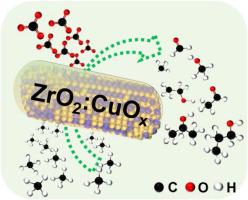Applied Catalysis B: Environment and Energy ( IF 20.2 ) Pub Date : 2020-09-23 , DOI: 10.1016/j.apcatb.2020.119572 Nengneng Xu , Cameron A. Coco , Yudong Wang , Tianshun Su , Yu Wang , Luwei Peng , Yanxing Zhang , Yuyu Liu , Jinli Qiao , Xiao-Dong Zhou

|
Research on the electro-conversion of methane has been driven by the necessity of addressing a key catalytic challenge to oxidize methane to liquid products at ambient conditions. In this work, we employed a series of binary metal oxide catalysts with capsule-like morphology by anchoring ZrO2 on Cu oxide (CuOx) for the oxidation of methane. The ZrO2:CuOx(180, 24) was found to convert methane with a difference in current density up to 13.35 mA cm−2 in comparison with ZrO2, CuOx, and other ZrO2:CuOx. The density functional theory calculations show that the enhanced activity originated from the increased charge distribution in ZrO2 after the ZrO2 cluster grew on the Cu2O(111), which enhances the activity of CH4 dissociation and improves the electronic conduction through Cu2O support. Benefiting from these advantages, the hybrids exhibit a high catalytic activity and stability. Surprisingly, 1-propanol and 2-propanol were the main products after 18 -h operation under ambient conditions.
中文翻译:

在“胶囊状”二元金属氧化物催化剂上将甲烷电转化为醇
甲烷电转化的研究已经受到解决关键催化挑战的推动,该挑战是在环境条件下将甲烷氧化为液体产物。在这项工作中,我们通过将ZrO 2锚定在Cu氧化物(CuO x)上用于甲烷氧化,采用了一系列具有胶囊状形态的二元金属氧化物催化剂。与ZrO 2,CuO x和其他ZrO 2:CuO x相比,发现ZrO 2:CuO x(180,24)可以转换甲烷,其电流密度差异高达13.35 mA cm -2。。密度泛函理论计算表明,增强的活性源于增加的电荷分布的ZrO 2的的ZrO后2簇生长在Cu 2 O(111),这增强CH的活性4离解,并通过铜改善电子传导2哦,支持。受益于这些优点,杂化物表现出高催化活性和稳定性。出人意料的是,在环境条件下运行18小时后,主要是1-丙醇和2-丙醇。










































 京公网安备 11010802027423号
京公网安备 11010802027423号